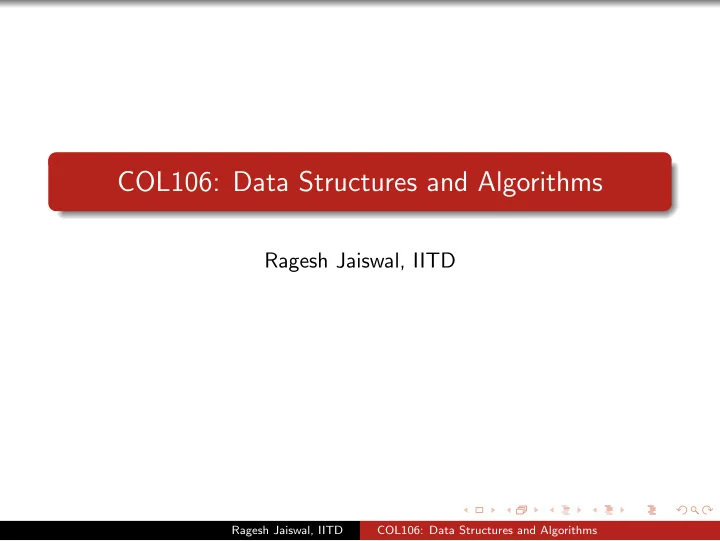

COL106: Data Structures and Algorithms Ragesh Jaiswal, IITD Ragesh Jaiswal, IITD COL106: Data Structures and Algorithms
Administrative Information Ragesh Jaiswal, IITD COL106: Data Structures and Algorithms
Administrative Information Course Instructor: Ragesh Jaiswal Email : rjaiswal@cse.iitd.ac.in Office: SIT 403 Course Time/Place: Lectures: Tue, Thu, Fri 11-12, LH 111 Teaching Assistants: TBD Ragesh Jaiswal, IITD COL106: Data Structures and Algorithms
Administrative Information Grading Scheme 1 Homework (programming) : 20% 2 Quizzes : 20% (weekly) 3 Minor : 30% (two minors 15% each) 4 Major : 30% Homework and Quizzes: Schedule for completion date of homework is posted on the course page. Homework will not be graded. However , there will be a quiz every week on the material given in the homework for the past week. Gradescope: A paperless grading system. Use the course code 9Z547M to register. Please use your formal email address from IIT Delhi. Policy on cheating: Students using unfair means will be severely penalised. Ragesh Jaiswal, IITD COL106: Data Structures and Algorithms
Administrative Information Textbooks: I will be following this book very closely. So, it will be a good idea to get a copy of this book. 1 Data Structures and Algorithms in Java by Michael T. Goodrich, Roberto Tamassia, and Michael H. Goldwasser . Other reference books: Introduction to Algorithms by Thomas H. Cormen, Charles E. Leiserson, Ronald L. Rivest, and Cliff Stein . Course webpage: http://www.cse.iitd.ac.in/~rjaiswal/2017/COL106/ . The site will contain course information, references, homework, course slides etc. Please check this page regularly. Ragesh Jaiswal, IITD COL106: Data Structures and Algorithms
Administrative Information Programming language: Java You are expected to be comfortable with the first two chapters of the Textbook. These chapters are introductions to Basic Java Programming and Object Oriented Programming. There is a java module on the course page. You are expected to go through this on your own. There will be a quiz based on the java module ( first three sessions only ). Ragesh Jaiswal, IITD COL106: Data Structures and Algorithms
Data Structures and Algorithms Ragesh Jaiswal, IITD COL106: Data Structures and Algorithms
Introduction Data Structure: Systematic way of organising and accessing data. Algorithm: A step-by-step procedure for performing some task. Ragesh Jaiswal, IITD COL106: Data Structures and Algorithms
Introduction How do we describe an algorithm? Algorithms are platform independent and so should be their description. This allows us to focus on the main ideas rather than spend time parsing the programming language specific syntax and the implementation details. Ragesh Jaiswal, IITD COL106: Data Structures and Algorithms
Introduction How do we describe an algorithm? Algorithms are platform independent and so should be their description. This allows us to focus on the main ideas rather than spend time parsing the programming language specific syntax and the implementation details. A concise way of describing algorithm is pseudocode. Pseudocode is not an actual code. It consists of: high-level programming constructs (if-then, for etc.) + natural language. Ragesh Jaiswal, IITD COL106: Data Structures and Algorithms
Introduction How do we describe an algorithm? Algorithms are platform independent and so should be their description. This allows us to focus on the main ideas rather than spend time parsing the programming language specific syntax and the implementation details. A concise way of describing algorithm is pseudocode. Pseudocode is not an actual code. It consists of: high-level programming constructs (if-then, for etc.) + natural language. Algorithm FindMin( A , n ) - min ← A [1] - for i = 2 to n - if ( A [ i ] < min ) - min ← A [ i ] - return ( min ) Ragesh Jaiswal, IITD COL106: Data Structures and Algorithms
Introduction How do we describe an algorithm? Algorithms are platform independent and so should be their description. This allows us to focus on the main ideas rather than spend time parsing the programming language specific syntax and the implementation details. A concise way of describing algorithm is pseudocode. Pseudocode is not an actual code. It consists of: high-level programming constructs (if-then, for etc.) + natural language. Algorithm FindMin( A , n ) - min ← A [1] - for i = 2 to n - if A [ i ] is smaller than min - min ← A [ i ] - return ( min ) Ragesh Jaiswal, IITD COL106: Data Structures and Algorithms
Introduction How do we describe an algorithm? Using a pseudocode. What are the desirable features of an algorithm? Ragesh Jaiswal, IITD COL106: Data Structures and Algorithms
Introduction How do we describe an algorithm? Using a pseudocode. What are the desirable features of an algorithm? It should be correct. It should run fast. It should take small amount of space (RAM). It should consume small amount of power. . . . Ragesh Jaiswal, IITD COL106: Data Structures and Algorithms
Introduction How do we describe an algorithm? Using a pseudocode. What are the desirable features of an algorithm? 1 It should be correct. 2 It should run fast. How do we argue that an algorithm is correct? Ragesh Jaiswal, IITD COL106: Data Structures and Algorithms
End Ragesh Jaiswal, IITD COL106: Data Structures and Algorithms
Recommend
More recommend